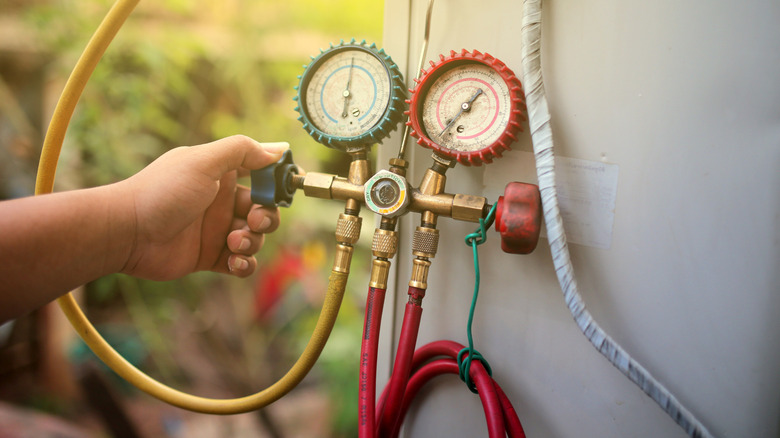How To Convert SCFM To CFM
Manufacturers of heating and cooling equipment express air exchange capacity in Cubic Feet per Minute (CFM), but this number varies according to the temperature and pressure of the air being exchanged. Partly for the sake of comparing products, manufacturers sometimes express capacity in Standard Cubic Feet per Minute (SCFM), which assumes a standard temperature and pressure. If you have an application that calls for a certain capacity at a specified temperature and pressure, and the capacity of the system you are considering lists capacity in SCFM, you need a way to convert between CFM and SCFM. An expression derived from the ideal gas law allows you to do that.
What Are CFM and SCFM?
Volumetric air flow is measured in cubic feet per minute, but because the density of air and other gases changes with temperature and pressure, this number varies. Density varies directly with pressure and inversely with temperature. Engineers often refer to CFM as Actual Cubic Feet per Minute (ACFM) to underline the relationship between airflow and air density.
Referring to an airflow at standard conditions removes the variability. Although more than one standard is in use in the world, the American Society of Mechanical Engineers uses the following standard values: Atmospheric pressure = 14.7 psi. Room temperature = 68 degrees Fahrenheit. Relative humidity = 36 percent. Air density = 0.075 lbs/cu.ft
When the capacity of a heating or cooling unit is expressed in SCFM, these are the conditions the value assumes.
Converting from SCFM to ACFM and back
The ideal gas law, pV = nRT, gives us the relationship between pressure, volume, and temperature of an ideal gas, where n is the number of moles of the gas and R is a constant. Air isn't an ideal gas, but we can get a useful comparison between SCFM and ACFM by considering it as such.
For the purpose of this calculation, m denotes the mass of the gas, which gives an expression for density (d), which is defined as the mass of the gas per unit volume (m/V); d = m/V = P/RT. Isolating the mass of the gas being moved (m) and dividing by the time it takes to move it gives the following expression: m/t = d(V/t). In words, the mass flow rate equals density multiplied by the volumetric flow rate.
Using this relationship and referring to the ideal gas law, we get the following expression: SCFM = ACFM (PA/PS • TS/TA ). In this, PA is actual pressure, PS is standard pressure, TA is actual temperature, and TS is standard temperature.
In the absolute scales required by the ideal gas law, standard atmospheric pressure is 14.7 psi and standard temperature is 528 degrees Rankine, which equals 68 degrees Fahrenheit. Using these values, we obtain: SCFM = ACFM (PA/14.7 psi) (528˚R/TA) and ACFM = SCFM (14.7 psi/PA) (TA/528˚R).
Accounting for humidity
The equation derived from the ideal gas law is useful for most situations, but because air is not an ideal gas, a more accurate relationship between ACFM and SCFM takes into account moisture content of the air: ACFM = SCFM • PS – (RHS • PVS)/Pb – (RHA • PVA) • TA/TS • Pb/PA.
In this equation, RHS is standard relative humidity, RHA is actual relative humidity, PVS is saturated vapor pressure of water at standard temperature, PVA is saturated vapor pressure of water at actual temperature, and Pb is barometric pressure.
